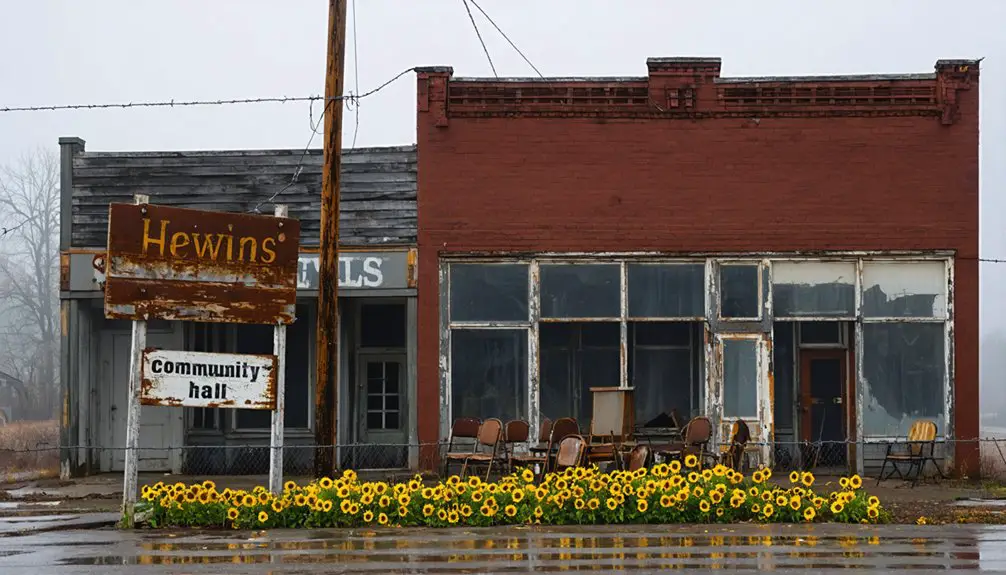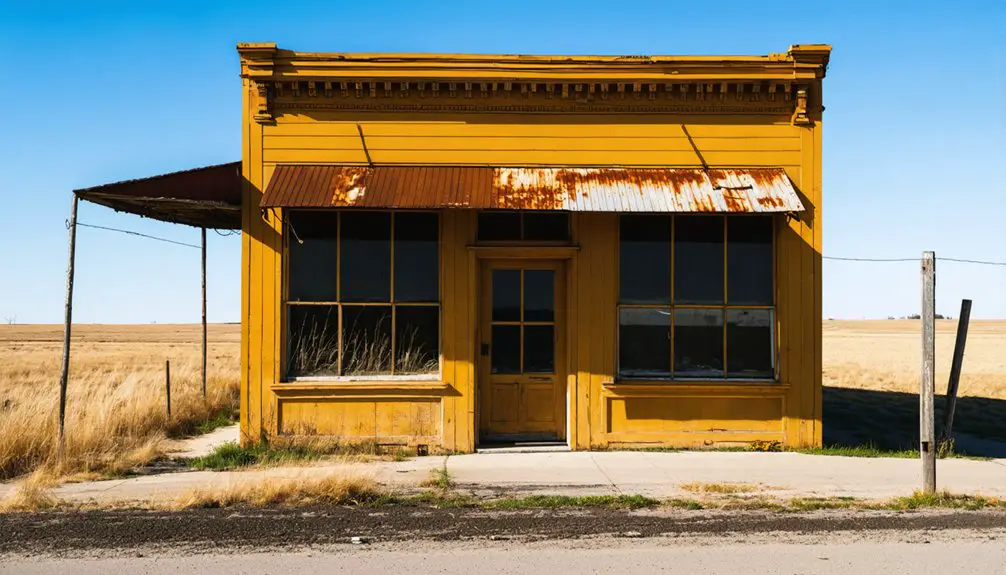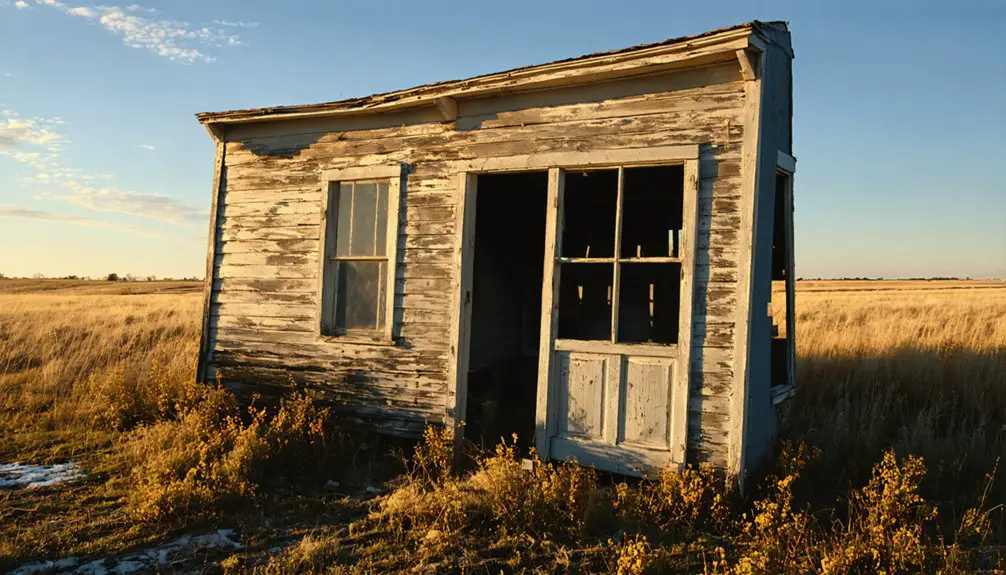You’ll find Hewins, Kansas 15 miles southwest of Sedan, where it flourished as a railroad town after the 1885 Caney River flood. The community grew to 225 residents by 1910, boasting two daily trains, three churches, and a vibrant Main Street with multiple businesses. The town’s decline began with its bank’s closure in 1924, and by 1966, when the post office shut down, Hewins had transformed into one of Kansas’s many ghost towns. Its abandoned buildings tell a deeper story of the American heartland.
Key Takeaways
- Hewins, Kansas peaked at 225 residents in 1910 but declined after its bank closed in 1924 and railroad service ended in the 1930s.
- Founded in 1885 after the Caney River flood, Hewins was a thriving railroad town with daily train service to neighboring communities.
- The town’s final operational milestone was the closure of its post office in 1966, marking the end of its functional existence.
- Today, only scattered remnants and abandoned homes remain as physical evidence of the once-prosperous prairie railroad town.
- Hewins exemplifies how transportation changes and economic shifts led to the extinction of many railroad-dependent communities in rural America.
The Founding Years: From Hart’s Mill to Hewins
When the severe Caney River flood struck in fall 1885, it set in motion events that would lead to Hewins’ establishment the following year.
You’ll find this Kansas town’s origins deeply connected to the post office relocation from Hart’s Mill in April 1887, marking a significant shift in the region’s development.
The flood influence prompted settlers to reconsider their locations, leading to new opportunities in what would become Hewins. Named after ranch owner Edwin M. Hewins, whose property stretched near Cedar Vale, the town emerged as a strategic location 15 miles southwest of Sedan. Like many Kansas towns of the era, diverse ethnic backgrounds contributed to its early settlement.
Nature’s fury reshaped settlement patterns, as displaced residents found promising prospects in Hewins, named for a prominent local rancher.
The arrival of the railway sealed Hewins’ fate as the area’s new hub, overtaking Hart’s Mill in importance. This transportation link would prove essential for the town’s early growth and development. The town quickly established itself as a commercial center with three grocery stores and various businesses by 1907.
Life in a Thriving Prairie Town
You’d find Hewins bustling with activity as two daily trains brought travelers and goods through the Atchison, Topeka & Santa Fe Railroad station, connecting residents to neighboring towns like Elgin and Cedar Vale.
Similar to Everest Church that served its community until 2001, Hewins’ three churches anchored the town’s spiritual life. The Women’s Christian Temperance Union, and Odd Fellows Lodge created a tight-knit social fabric where community members gathered regularly.
Main Street commerce thrived with three grocery stores, two drug stores, a hotel, and various service businesses that met the daily needs of Hewins’ 225 residents. The town grew significantly by 1907, becoming an important economic center for the region.
Daily Railroad Hub Activity
During its peak years, Hewins bustled with the daily rhythm of two passenger and freight trains that served as the town’s lifeline to the wider region.
You’d find the railroad depot humming with activity as morning trains departed for Elgin and Cedar Vale, returning in the evening. Train schedules governed the town’s daily patterns, while telegraph operators kept communication flowing between rail stations. By 1874, rail service had been reduced to one train daily, reflecting broader changes in regional transportation.
The depot’s freight handling operations made Hewins a crucial collection point for local agriculture.
You’d see farmers bringing grain and livestock for shipment, while merchants received goods for their stores. Local blacksmiths and livery barns supported these operations, maintaining the equipment needed to move cargo between rail cars and wagons.
Social Organizations Enriched Community
As Hewins matured into a vibrant prairie community by 1907, social organizations became the heartbeat of local life.
You’d find three churches serving as spiritual anchors, hosting gatherings and coordinating charitable work to strengthen social cohesion. The Odd Fellow’s Lodge provided essential community support through mutual aid and social networking. Similar to historic Bell Plane, the community thrived on agricultural roots.
Like many Kansas towns of the era, Hewins experienced significant population decline over time.
The town’s educational foundation centered on a well-regarded school, where your children would receive quality instruction while fostering connections among local families.
You could count on professional services from two doctors, a dentist, and various merchants to meet your daily needs.
Whether you gathered at church socials, lodge meetings, or community celebrations, you’d experience a rich tapestry of prairie life supported by active religious groups, fraternal organizations, and civic institutions.
Bustling Main Street Commerce
The bustling streets of Hewins showcased a thriving commercial district by 1910, with three grocery stores, two drug stores, and a bank serving its 225 residents.
Much like the Oregon Trail near Bigelow, Main street businesses catered to both locals and travelers, offering essential services through a hotel, restaurant, and livery barn. You’d find everything you needed without leaving town.
Local commerce flourished thanks to the Atchison, Topeka & Santa Fe Railroad, which connected you to nearby communities like Elgin and Cedar Vale via two daily trains.
The town’s business district supported your daily needs through telegraph and express offices, while professional services included two doctors and a dentist.
For repairs and maintenance, you could visit one of two blacksmith shops that kept the farming community’s equipment running smoothly.
Like many Kansas towns, Hewins faced severe weather conditions that would eventually contribute to its decline and abandonment.
Transportation and Economic Growth
Located strategically along the Atchison, Topeka & Santa Fe Railroad by 1910, Hewins experienced its most significant period of economic growth through essential transportation connections.
You’d find two daily trains connecting you to Elgin and Cedar Vale, while telegraph and express offices kept you linked to the wider world. This transportation legacy supported a thriving community of 225 residents at its peak. Like Bonita, Kansas, it was chosen for rail when establishing the town location.
The town’s economic interdependence with its transport systems became clear when rail service ended in the 1930s.
Without modernized roads to replace the lost rail connection, you’d watch Hewins’ businesses and bank close their doors. By 1966, even the post office shut down, marking the end of regular commerce.
Today, you’ll find only scattered homes where this once-connected community stood.
Community Spirit and Social Organizations

Strong community bonds shaped daily life in Hewins during its prime years, with three churches and multiple social organizations creating a rich tapestry of rural fellowship by 1907.
You’d find community cohesion reflected in the bustling activities of the Women’s Christian Temperance Union and the local Odd Fellow’s Lodge, where fraternal bonding and mutual aid flourished.
The town’s “good school” served as more than just an educational facility – it was a cornerstone of social life where families gathered for events and programs.
Churches doubled as social hubs, hosting charitable activities and moral guidance sessions. Women played a crucial role through their involvement in the WCTU, running educational programs and shaping the town’s social standards.
Regular train service kept Hewins connected to neighboring communities, enriching cultural exchange.
The Path to Abandonment
You’ll find Hewins’ decline was triggered by the closure of its bank in 1924, marking the beginning of economic instability in this once-thriving railroad town.
The loss of rail service in the 1930s dealt another devastating blow, cutting off essential transportation links that had sustained commerce and travel since 1910.
With its primary economic lifelines severed, the town steadily lost population and businesses until its post office finally closed in 1966, completing its transformation into a ghost town.
Economic Forces Drive Decline
As economic pressures mounted in the early 1900s, Hewins began its steady descent into abandonment through a series of devastating losses.
You’d have witnessed the town’s economic challenges unfold when its only bank closed in 1924, crippling access to essential credit and capital. The agricultural revolution dealt another blow as mechanization reduced farm labor needs, while business consolidation meant fewer family farms sustained the community.
Once-thriving commercial enterprises – from grocery stores to the hotel – shuttered as the population dwindled. Despite the community’s resilience, Hewins couldn’t overcome the exodus of working-age residents to urban centers.
When the post office closed in 1966, it marked the end of an era, as the town that had peaked at 225 residents in 1910 transformed into a shadow of its former self.
Transportation Links Dissolve
Once an essential transportation hub served by the Atchison, Topeka & Santa Fe Railroad, Hewins saw its lifeline begin to unravel in the 1930s when train service abruptly ended.
You’d have found yourself increasingly isolated as the town’s transportation infrastructure deteriorated, with only dirt and county roads remaining where trains once ran.
While neighboring towns adapted to automotive culture with paved roads and highway connections, Hewins couldn’t sustain its railway dependence or shift to modern transport networks.
The impact rippled through every aspect of daily life – mail delivery suffered, telegraph services vanished, and by 1966, even the post office shut down.
As regional commerce shifted to better-connected towns like Sedan, fifteen miles northeast, you’d have watched Hewins slip further into obscurity.
Legacy and Present-Day Remnants

While most physical traces of Hewins have vanished, the town’s legacy endures through scattered remnants and historical records.
You’ll find the ghost town about 15 miles southwest of Sedan, where a few abandoned homes stand as silent witnesses to its historical significance. Though no businesses or community institutions remain operational, the site preserves the memory of a once-thriving railroad town that boasted multiple stores, a bank, and various social organizations.
The legacy preservation efforts continue through documentation in Kansas historical texts and genealogical societies.
You can explore Hewins’ story through online repositories and historical YouTube content, where it serves as a compelling example of how railroad-dependent communities rose and fell in early Kansas. The town’s extinction reflects broader patterns of rural economic transformation in the American heartland.
Frequently Asked Questions
What Happened to Edwin M. Hewins After the Town Was Established?
After founding the town, you’d find Edwin continuing his entrepreneurship through ranching, serving in Kansas Legislature until his death in 1898. His legacy remained strong through Hewins’ early development.
Were There Any Notable Crimes or Incidents in Hewins’ History?
You won’t find any unsolved mysteries or crime patterns in historical records. The town’s challenges centered on natural disasters like flooding and economic decline rather than criminal incidents.
What Natural Disasters Affected Hewins Besides the 1885 Flood?
While drought effects and tornado occurrences were common in southeast Kansas, you won’t find documented evidence of other natural disasters impacting Hewins after the 1885 flood that sparked its relocation.
Did Any Famous People Ever Visit or Live in Hewins?
While you might expect some famous visitors or notable residents in a railroad town, historical records don’t show any celebrities ever living in or passing through during Hewins’ active years.
How Did Native American Relations Impact the Early Development of Hewins?
Native treaties reshaped the land before you’d see Hewins emerge. Early cultural exchange through trading posts and Native commerce influenced the area’s initial development as a strategic settlement point.
References
- https://legendsofkansas.com/hewins-kansas/
- https://www.youtube.com/watch?v=VPZtNoncnig
- https://www.youtube.com/watch?v=alC1wDdSVvg
- https://en.wikipedia.org/wiki/List_of_ghost_towns_in_Kansas
- https://legendsofkansas.com/chautauqua-county-extinct-towns/
- https://fhsuguides.fhsu.edu/kansasheritage/thomascounty
- https://genealogytrails.com/kan/chautauqua/hist_history.html
- https://www.hhhistory.com/2019/05/ghost-towns-of-kansas.html
- https://www.baldhiker.com/kansas-old-prairie-town-topeka/
- https://www.legendsofamerica.com/whats-new/



